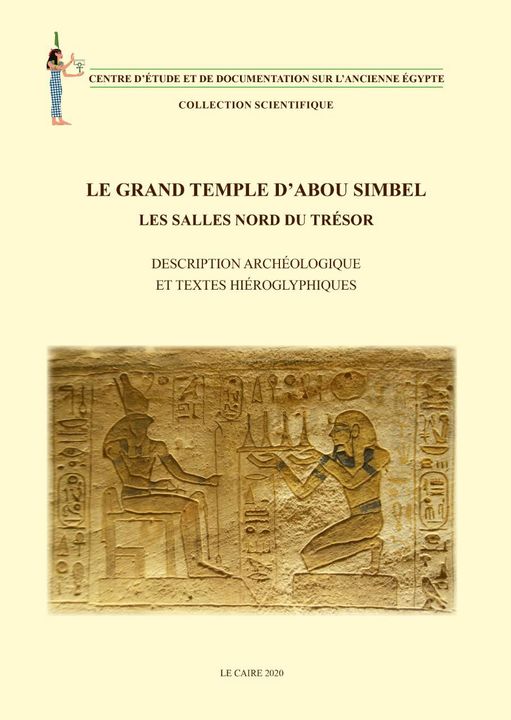
فى إطار الدور العلمى الرائد الذى يلعبه فى تسجيل وتوثيق الآثار المصرية، أصدر مركز تسجيل الآثار المصرية بوزارة السياحة والآثار كتاب جديد باللغة الفرنسية بعنوان: “حجرات الكنز الشمالية بمعبد أبو سمبل الكبير”.
وأوضح الدكتور هشام الليثى، رئيس الإدارة المركزية لتسجيل الآثار المصرية، أن الكتاب يبدأ بمقدمه تتناول ما أصدره المركز عن هذا المعبد من قبل، ثم ما يتضمنه الإصدار الحالى عن حجرات الكنز الشمالية بالمعبد، والذي يحوى الوصف الأثرى وترجمة النصوص الهيروغليفية، حيث يوضح الكتاب التخطيط المعماري للمعبد مع إشارة إلى مكان حجرات الكنز الشمالية، ثم الوصف الأثرى للنقوش والمناظر، ثم مجموعة الصور الفوتوغرافية الخاصة بتلك النقوش والمناظر، يلى ذلك لوحات الرسومات الخطية (الفاكسميلى)، وخرائط معمارية، وصور أبيض وأسود، ولوح فاكسميلى للنقوش والمناظر، بالإضافة إلى قائمة للقرابين والطقوس، وأسماء المعبودات، واللوحات، والرسومات الخطية.
وقد قام الدكتور وزير السياحة والآثار بكتابة مقدمة الكتاب.
جدير بالذكر ان المركز كان قد أصدر مجموعة من الكتب عن هذا المعبد منها: معركة قادش (1971) – التخطيط المعماري للمعبد (1984) – حجرات الكنز الجنوبية (1975) – مقصورة المعبود “رع حورآختى” (1958 و 1989) – واجهة المعبد (1997) – معبد أبو سمبل الصغير (1968) – كتاب تذكارى عن المعبد يضم صور فوتوغرافية (1968).
وقد أصدر المركز مؤخرا سلسلة من الإصدارات العلمية تضمنت (مقابر وادى الملكات – مقبرة خع إم حات رقم 57 – معبد جرف حسين – مقبرة نفرتارى رقم 66).
ويُذكر أن معبد أبو سمبل الكبير يقع بمنطقة النوبة، على الضفة الغربية لبحيرة ناصر، وهو أحد المواقع الأثرية المُدرجة ضمن قائمة اليونسكو لمواقع التراث العالمى، وهو أحد المعابد التى تم نقلها من مكانها الأصلى إلى مكان مرتفع عن سطح بحيرة ناصر وقت بناء السد العالى.
وقد قام الملك رمسيس الثانى من الأسرة التاسعة عشرة بتشييد هذا المعبد، حيث تم اكتشافه بواسطة عالم الآثار “جيوفانى بيلزونى”، عام 1817م.
The Minister of Tourism and Antiquities wrote the introduction to the book.It is worth noting that the center had issued a set of books on this temple, including: The Battle of Kadesh (1971) – The Architectural Planning for the Temple (1984) – The Southern Treasure Chambers (1975) – The Shrine of the Goddess “Ra Horakhati” (1958 and 1989) – The Facade of the Temple ( 1997) – The Little Abu Simbel Temple (1968) – A memorial book about the temple, including photographs (1968).
The center recently issued a series of scientific publications that included (The Queens Valley Cemetery – Kha Im Hat Tomb No. 57 – Jurf Hussein Temple – Nefertari Tomb No. 66)
It is noteworthy that the Great Temple of Abu Simbel is located in the Nubia region, on the western bank of Lake Nasser, and it is one of the archaeological sites included in the UNESCO list of World Heritage Sites, and it is one of the temples that was moved from its original location to a place high above the surface of Lake Nasser at the time of the construction of the High Dam.
This temple was built by King Ramses II of the Nineteenth Dynasty, and it was discovered by the archaeologist Giovanni Belzoni, in 1817.